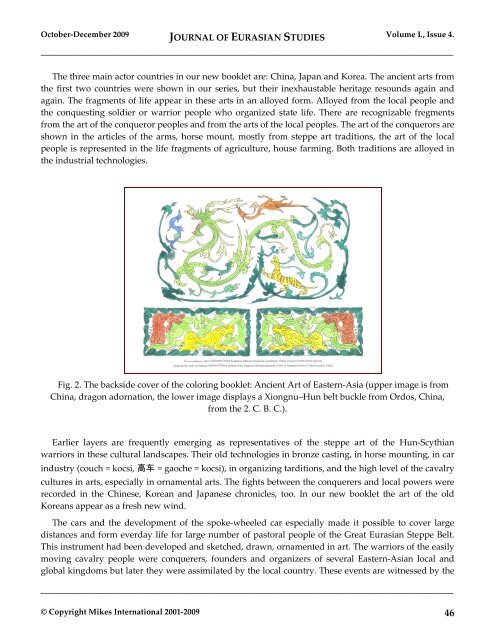JOURNAL OF EURASIAN STUDIES
JOURNAL OF EURASIAN STUDIES
JOURNAL OF EURASIAN STUDIES
Create successful ePaper yourself
Turn your PDF publications into a flip-book with our unique Google optimized e-Paper software.
October-December 2009 <strong>JOURNAL</strong> <strong>OF</strong> <strong>EURASIAN</strong> <strong>STUDIES</strong> Volume I., Issue 4.<br />
_____________________________________________________________________________________<br />
The three main actor countries in our new booklet are: China, Japan and Korea. The ancient arts from<br />
the first two countries were shown in our series, but their inexhaustable heritage resounds again and<br />
again. The fragments of life appear in these arts in an alloyed form. Alloyed from the local people and<br />
the conquesting soldier or warrior people who organized state life. There are recognizable fregments<br />
from the art of the conqueror peoples and from the arts of the local peoples. The art of the conquerors are<br />
shown in the articles of the arms, horse mount, mostly from steppe art traditions, the art of the local<br />
people is represented in the life fragments of agriculture, house farming. Both traditions are alloyed in<br />
the industrial technologies.<br />
Fig. 2. The backside cover of the coloring booklet: Ancient Art of Eastern-Asia (upper image is from<br />
China, dragon adornation, the lower image displays a Xiongnu–Hun belt buckle from Ordos, China,<br />
from the 2. C. B. C.).<br />
Earlier layers are frequently emerging as representatives of the steppe art of the Hun-Scythian<br />
warriors in these cultural landscapes. Their old technologies in bronze casting, in horse mounting, in car<br />
industry (couch = kocsi, 高车 = gaoche = kocsi), in organizing tarditions, and the high level of the cavalry<br />
cultures in arts, especially in ornamental arts. The fights between the conquerers and local powers were<br />
recorded in the Chinese, Korean and Japanese chronicles, too. In our new booklet the art of the old<br />
Koreans appear as a fresh new wind.<br />
The cars and the development of the spoke-wheeled car especially made it possible to cover large<br />
distances and form everday life for large number of pastoral people of the Great Eurasian Steppe Belt.<br />
This instrument had been developed and sketched, drawn, ornamented in art. The warriors of the easily<br />
moving cavalry people were conquerers, founders and organizers of several Eastern-Asian local and<br />
global kingdoms but later they were assimilated by the local country. These events are witnessed by the<br />
_____________________________________________________________________________________<br />
© Copyright Mikes International 2001-2009 46
















